Nursing Assignment on Hand Hygiene Practices and Healthcare Infections
VerifiedAdded on 2021/10/16
|12
|2581
|66
Report
AI Summary
This nursing assignment report critically examines the effectiveness of hand hygiene practices in reducing healthcare-associated infections (HAIs). The report begins with an introduction defining HAIs and highlighting the significance of hand hygiene in preventing them, supported by statistical data on HAI prevalence. A PICO statement is formulated to guide the literature search, which includes electronic databases like St. Lawrence College database, Google scholar and PubMed. The search strategy, inclusion criteria, and a literature chart summarizing key findings from ten selected articles are presented. These articles explore various aspects of hand hygiene, including compliance rates, the use of alcohol-based hand rubs, multimodal approaches, and the impact of WHO strategies. The report synthesizes the findings, highlighting the positive correlation between hand hygiene compliance and reduced HAI rates. The conclusion emphasizes the importance of adequate resources and the implementation of effective hand hygiene strategies, reinforcing the notion that hand hygiene among healthcare workers is more effective in reducing HAIs than unhygienic practices. References are provided to support the findings.
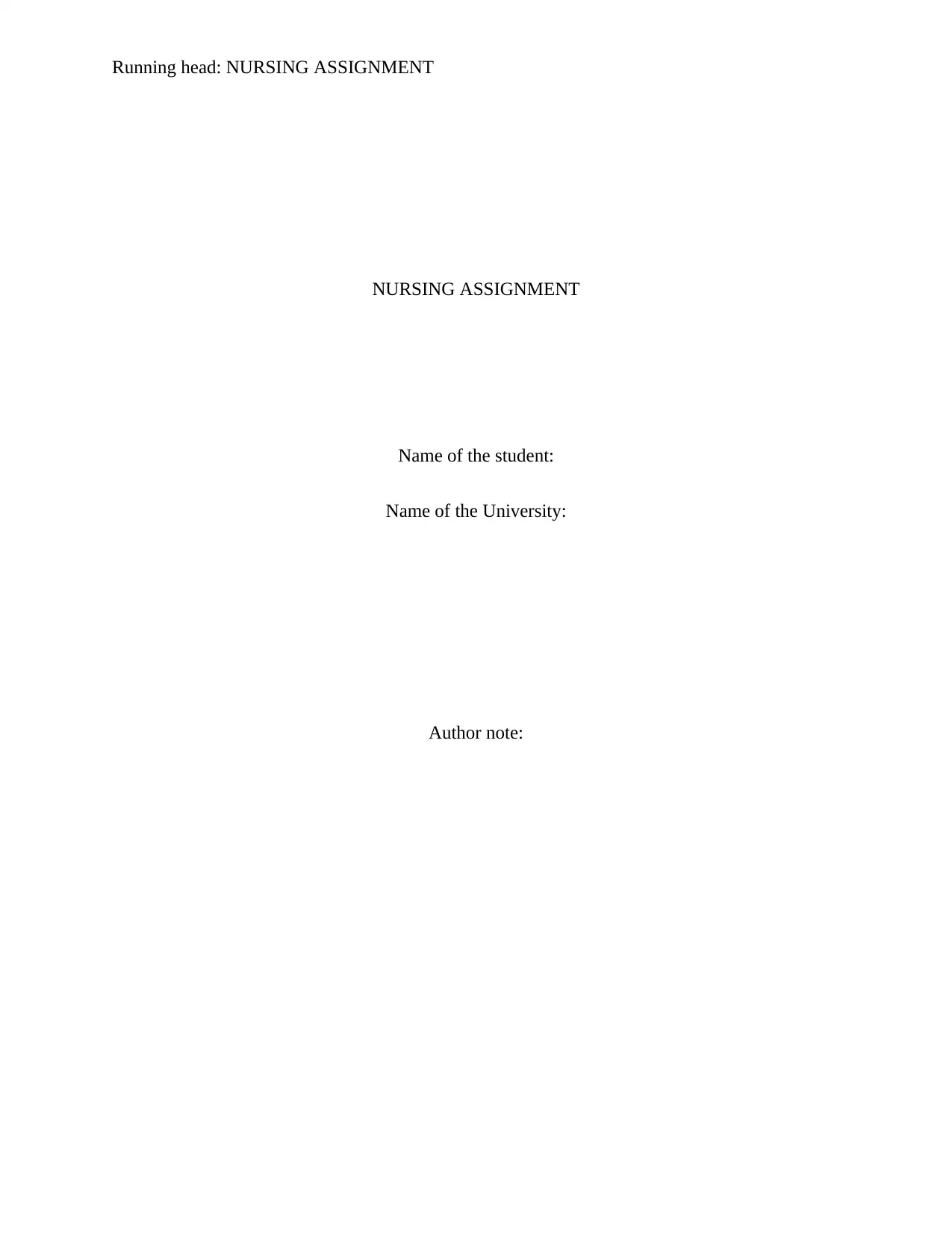
Running head: NURSING ASSIGNMENT
NURSING ASSIGNMENT
Name of the student:
Name of the University:
Author note:
NURSING ASSIGNMENT
Name of the student:
Name of the University:
Author note:
Paraphrase This Document
Need a fresh take? Get an instant paraphrase of this document with our AI Paraphraser
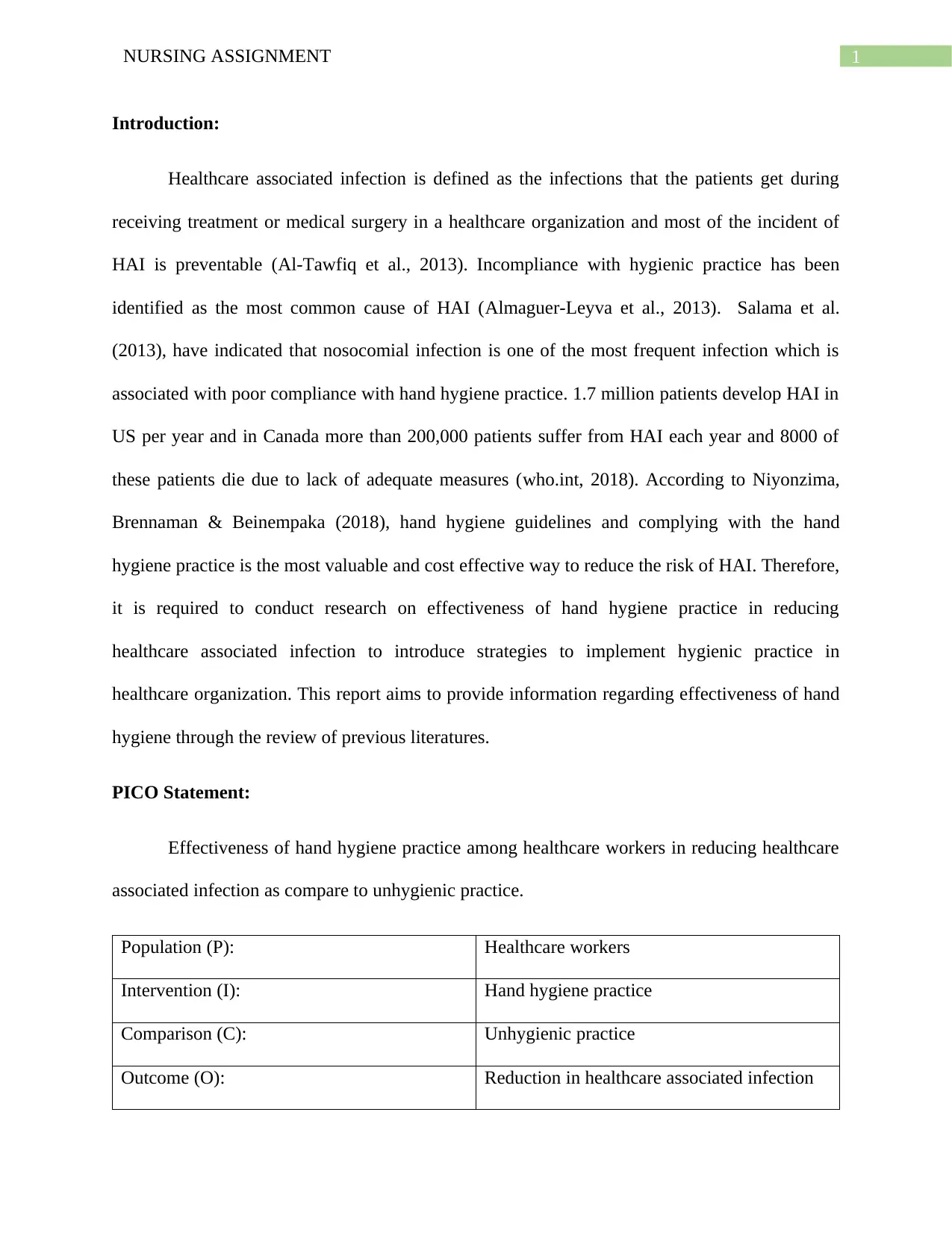
1NURSING ASSIGNMENT
Introduction:
Healthcare associated infection is defined as the infections that the patients get during
receiving treatment or medical surgery in a healthcare organization and most of the incident of
HAI is preventable (Al-Tawfiq et al., 2013). Incompliance with hygienic practice has been
identified as the most common cause of HAI (Almaguer-Leyva et al., 2013). Salama et al.
(2013), have indicated that nosocomial infection is one of the most frequent infection which is
associated with poor compliance with hand hygiene practice. 1.7 million patients develop HAI in
US per year and in Canada more than 200,000 patients suffer from HAI each year and 8000 of
these patients die due to lack of adequate measures (who.int, 2018). According to Niyonzima,
Brennaman & Beinempaka (2018), hand hygiene guidelines and complying with the hand
hygiene practice is the most valuable and cost effective way to reduce the risk of HAI. Therefore,
it is required to conduct research on effectiveness of hand hygiene practice in reducing
healthcare associated infection to introduce strategies to implement hygienic practice in
healthcare organization. This report aims to provide information regarding effectiveness of hand
hygiene through the review of previous literatures.
PICO Statement:
Effectiveness of hand hygiene practice among healthcare workers in reducing healthcare
associated infection as compare to unhygienic practice.
Population (P): Healthcare workers
Intervention (I): Hand hygiene practice
Comparison (C): Unhygienic practice
Outcome (O): Reduction in healthcare associated infection
Introduction:
Healthcare associated infection is defined as the infections that the patients get during
receiving treatment or medical surgery in a healthcare organization and most of the incident of
HAI is preventable (Al-Tawfiq et al., 2013). Incompliance with hygienic practice has been
identified as the most common cause of HAI (Almaguer-Leyva et al., 2013). Salama et al.
(2013), have indicated that nosocomial infection is one of the most frequent infection which is
associated with poor compliance with hand hygiene practice. 1.7 million patients develop HAI in
US per year and in Canada more than 200,000 patients suffer from HAI each year and 8000 of
these patients die due to lack of adequate measures (who.int, 2018). According to Niyonzima,
Brennaman & Beinempaka (2018), hand hygiene guidelines and complying with the hand
hygiene practice is the most valuable and cost effective way to reduce the risk of HAI. Therefore,
it is required to conduct research on effectiveness of hand hygiene practice in reducing
healthcare associated infection to introduce strategies to implement hygienic practice in
healthcare organization. This report aims to provide information regarding effectiveness of hand
hygiene through the review of previous literatures.
PICO Statement:
Effectiveness of hand hygiene practice among healthcare workers in reducing healthcare
associated infection as compare to unhygienic practice.
Population (P): Healthcare workers
Intervention (I): Hand hygiene practice
Comparison (C): Unhygienic practice
Outcome (O): Reduction in healthcare associated infection
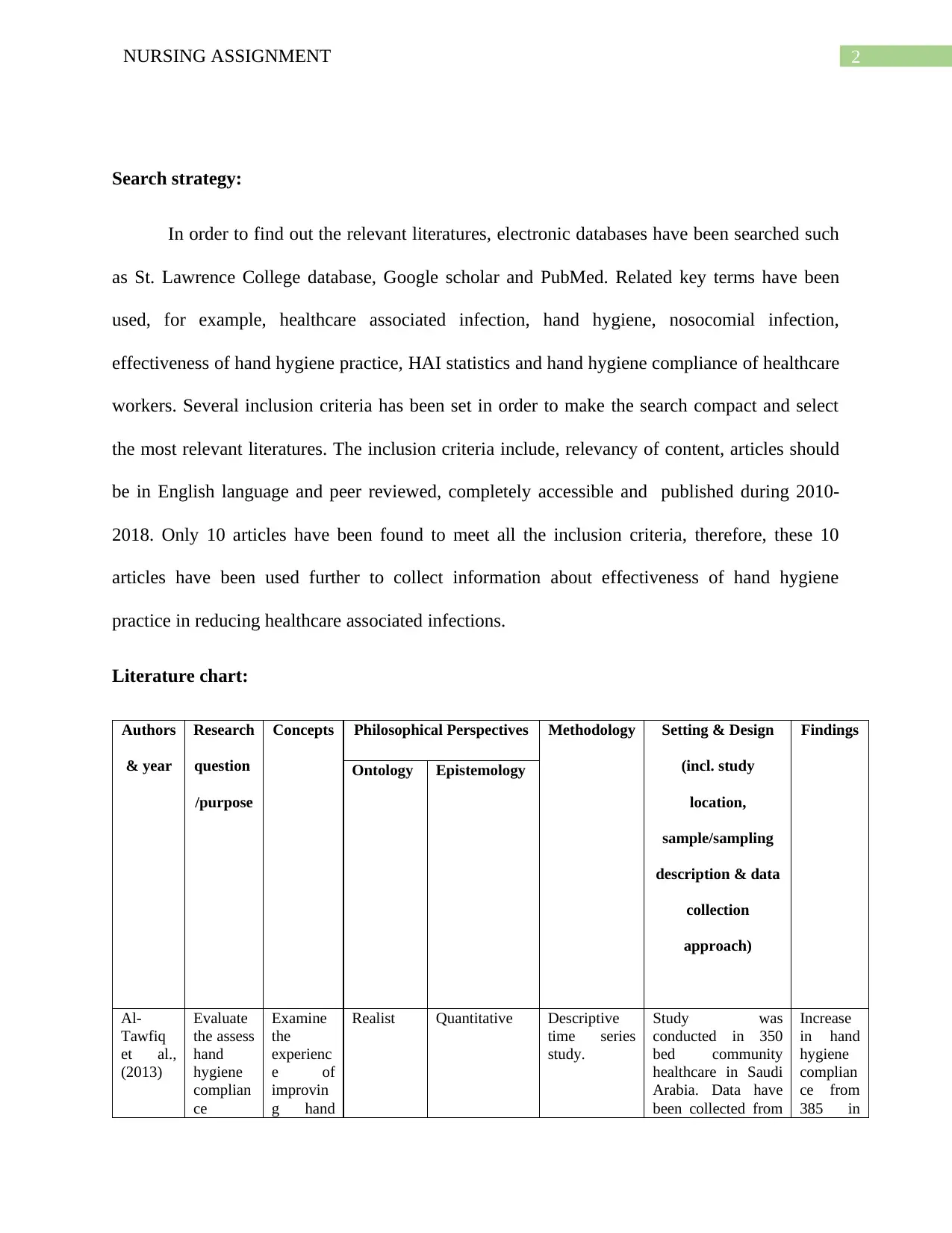
2NURSING ASSIGNMENT
Search strategy:
In order to find out the relevant literatures, electronic databases have been searched such
as St. Lawrence College database, Google scholar and PubMed. Related key terms have been
used, for example, healthcare associated infection, hand hygiene, nosocomial infection,
effectiveness of hand hygiene practice, HAI statistics and hand hygiene compliance of healthcare
workers. Several inclusion criteria has been set in order to make the search compact and select
the most relevant literatures. The inclusion criteria include, relevancy of content, articles should
be in English language and peer reviewed, completely accessible and published during 2010-
2018. Only 10 articles have been found to meet all the inclusion criteria, therefore, these 10
articles have been used further to collect information about effectiveness of hand hygiene
practice in reducing healthcare associated infections.
Literature chart:
Authors
& year
Research
question
/purpose
Concepts Philosophical Perspectives Methodology Setting & Design
(incl. study
location,
sample/sampling
description & data
collection
approach)
Findings
Ontology Epistemology
Al-
Tawfiq
et al.,
(2013)
Evaluate
the assess
hand
hygiene
complian
ce
Examine
the
experienc
e of
improvin
g hand
Realist Quantitative Descriptive
time series
study.
Study was
conducted in 350
bed community
healthcare in Saudi
Arabia. Data have
been collected from
Increase
in hand
hygiene
complian
ce from
385 in
Search strategy:
In order to find out the relevant literatures, electronic databases have been searched such
as St. Lawrence College database, Google scholar and PubMed. Related key terms have been
used, for example, healthcare associated infection, hand hygiene, nosocomial infection,
effectiveness of hand hygiene practice, HAI statistics and hand hygiene compliance of healthcare
workers. Several inclusion criteria has been set in order to make the search compact and select
the most relevant literatures. The inclusion criteria include, relevancy of content, articles should
be in English language and peer reviewed, completely accessible and published during 2010-
2018. Only 10 articles have been found to meet all the inclusion criteria, therefore, these 10
articles have been used further to collect information about effectiveness of hand hygiene
practice in reducing healthcare associated infections.
Literature chart:
Authors
& year
Research
question
/purpose
Concepts Philosophical Perspectives Methodology Setting & Design
(incl. study
location,
sample/sampling
description & data
collection
approach)
Findings
Ontology Epistemology
Al-
Tawfiq
et al.,
(2013)
Evaluate
the assess
hand
hygiene
complian
ce
Examine
the
experienc
e of
improvin
g hand
Realist Quantitative Descriptive
time series
study.
Study was
conducted in 350
bed community
healthcare in Saudi
Arabia. Data have
been collected from
Increase
in hand
hygiene
complian
ce from
385 in
⊘ This is a preview!⊘
Do you want full access?
Subscribe today to unlock all pages.

Trusted by 1+ million students worldwide
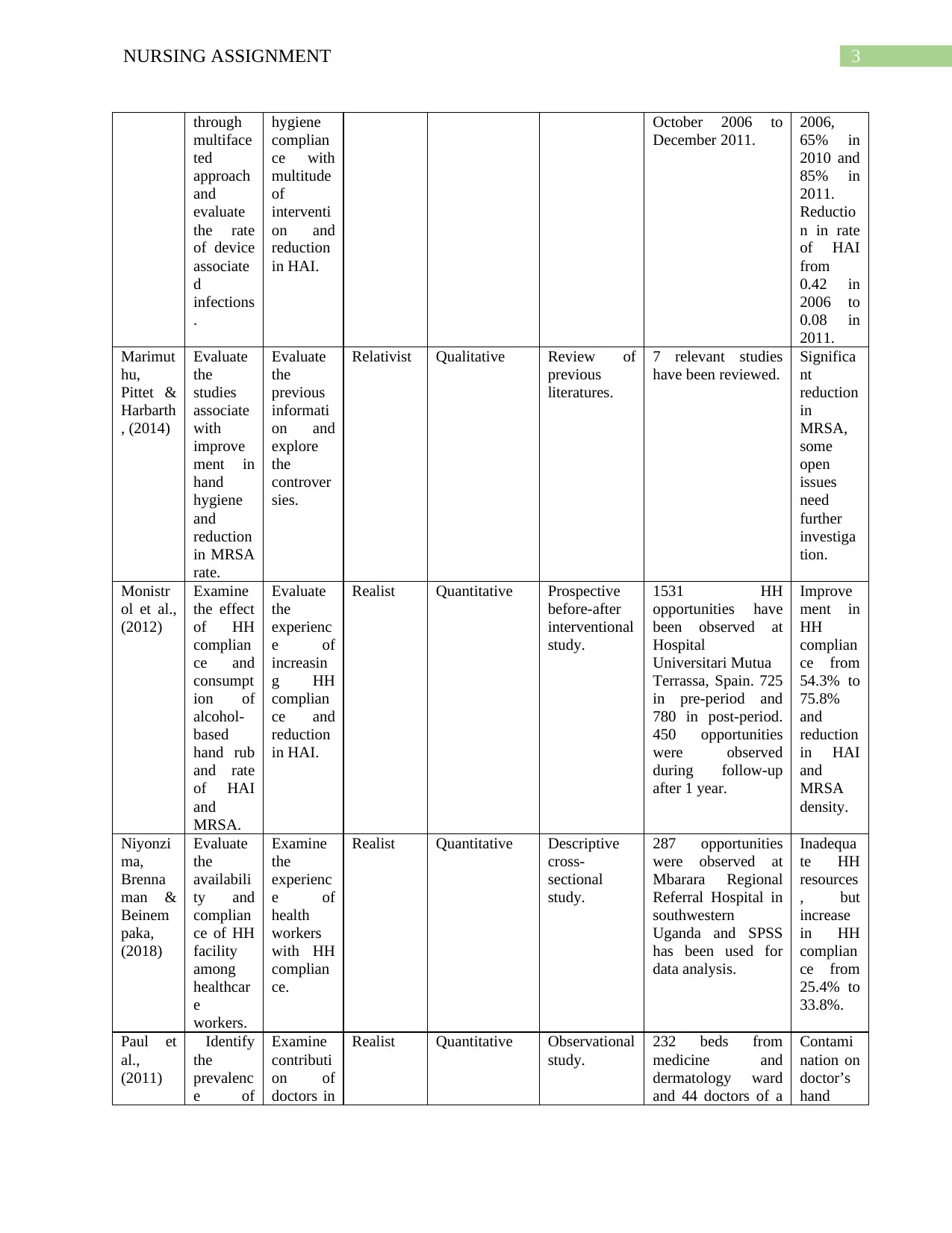
3NURSING ASSIGNMENT
through
multiface
ted
approach
and
evaluate
the rate
of device
associate
d
infections
.
hygiene
complian
ce with
multitude
of
interventi
on and
reduction
in HAI.
October 2006 to
December 2011.
2006,
65% in
2010 and
85% in
2011.
Reductio
n in rate
of HAI
from
0.42 in
2006 to
0.08 in
2011.
Marimut
hu,
Pittet &
Harbarth
, (2014)
Evaluate
the
studies
associate
with
improve
ment in
hand
hygiene
and
reduction
in MRSA
rate.
Evaluate
the
previous
informati
on and
explore
the
controver
sies.
Relativist Qualitative Review of
previous
literatures.
7 relevant studies
have been reviewed.
Significa
nt
reduction
in
MRSA,
some
open
issues
need
further
investiga
tion.
Monistr
ol et al.,
(2012)
Examine
the effect
of HH
complian
ce and
consumpt
ion of
alcohol-
based
hand rub
and rate
of HAI
and
MRSA.
Evaluate
the
experienc
e of
increasin
g HH
complian
ce and
reduction
in HAI.
Realist Quantitative Prospective
before-after
interventional
study.
1531 HH
opportunities have
been observed at
Hospital
Universitari Mutua
Terrassa, Spain. 725
in pre-period and
780 in post-period.
450 opportunities
were observed
during follow-up
after 1 year.
Improve
ment in
HH
complian
ce from
54.3% to
75.8%
and
reduction
in HAI
and
MRSA
density.
Niyonzi
ma,
Brenna
man &
Beinem
paka,
(2018)
Evaluate
the
availabili
ty and
complian
ce of HH
facility
among
healthcar
e
workers.
Examine
the
experienc
e of
health
workers
with HH
complian
ce.
Realist Quantitative Descriptive
cross-
sectional
study.
287 opportunities
were observed at
Mbarara Regional
Referral Hospital in
southwestern
Uganda and SPSS
has been used for
data analysis.
Inadequa
te HH
resources
, but
increase
in HH
complian
ce from
25.4% to
33.8%.
Paul et
al.,
(2011)
Identify
the
prevalenc
e of
Examine
contributi
on of
doctors in
Realist Quantitative Observational
study.
232 beds from
medicine and
dermatology ward
and 44 doctors of a
Contami
nation on
doctor’s
hand
through
multiface
ted
approach
and
evaluate
the rate
of device
associate
d
infections
.
hygiene
complian
ce with
multitude
of
interventi
on and
reduction
in HAI.
October 2006 to
December 2011.
2006,
65% in
2010 and
85% in
2011.
Reductio
n in rate
of HAI
from
0.42 in
2006 to
0.08 in
2011.
Marimut
hu,
Pittet &
Harbarth
, (2014)
Evaluate
the
studies
associate
with
improve
ment in
hand
hygiene
and
reduction
in MRSA
rate.
Evaluate
the
previous
informati
on and
explore
the
controver
sies.
Relativist Qualitative Review of
previous
literatures.
7 relevant studies
have been reviewed.
Significa
nt
reduction
in
MRSA,
some
open
issues
need
further
investiga
tion.
Monistr
ol et al.,
(2012)
Examine
the effect
of HH
complian
ce and
consumpt
ion of
alcohol-
based
hand rub
and rate
of HAI
and
MRSA.
Evaluate
the
experienc
e of
increasin
g HH
complian
ce and
reduction
in HAI.
Realist Quantitative Prospective
before-after
interventional
study.
1531 HH
opportunities have
been observed at
Hospital
Universitari Mutua
Terrassa, Spain. 725
in pre-period and
780 in post-period.
450 opportunities
were observed
during follow-up
after 1 year.
Improve
ment in
HH
complian
ce from
54.3% to
75.8%
and
reduction
in HAI
and
MRSA
density.
Niyonzi
ma,
Brenna
man &
Beinem
paka,
(2018)
Evaluate
the
availabili
ty and
complian
ce of HH
facility
among
healthcar
e
workers.
Examine
the
experienc
e of
health
workers
with HH
complian
ce.
Realist Quantitative Descriptive
cross-
sectional
study.
287 opportunities
were observed at
Mbarara Regional
Referral Hospital in
southwestern
Uganda and SPSS
has been used for
data analysis.
Inadequa
te HH
resources
, but
increase
in HH
complian
ce from
25.4% to
33.8%.
Paul et
al.,
(2011)
Identify
the
prevalenc
e of
Examine
contributi
on of
doctors in
Realist Quantitative Observational
study.
232 beds from
medicine and
dermatology ward
and 44 doctors of a
Contami
nation on
doctor’s
hand
Paraphrase This Document
Need a fresh take? Get an instant paraphrase of this document with our AI Paraphraser
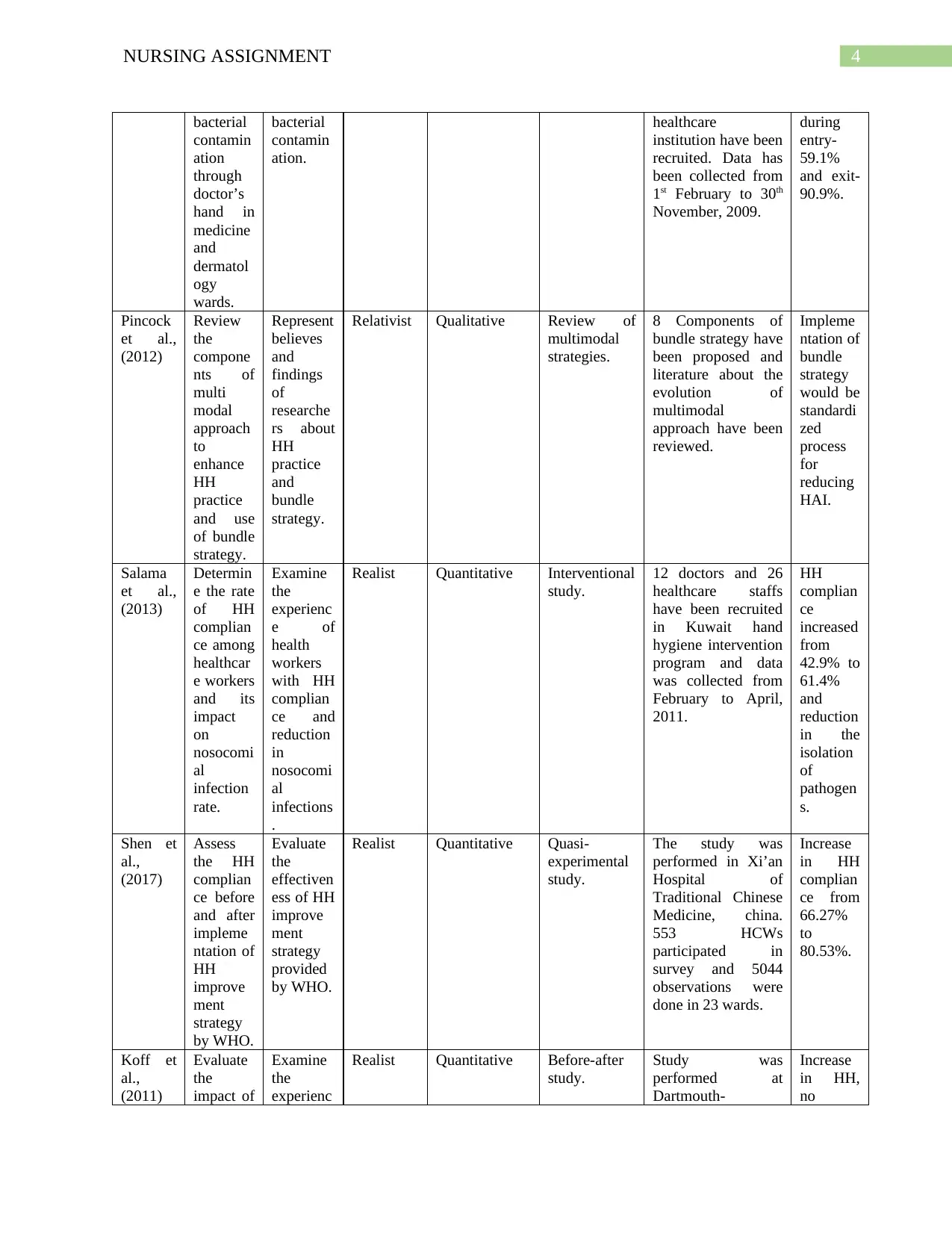
4NURSING ASSIGNMENT
bacterial
contamin
ation
through
doctor’s
hand in
medicine
and
dermatol
ogy
wards.
bacterial
contamin
ation.
healthcare
institution have been
recruited. Data has
been collected from
1st February to 30th
November, 2009.
during
entry-
59.1%
and exit-
90.9%.
Pincock
et al.,
(2012)
Review
the
compone
nts of
multi
modal
approach
to
enhance
HH
practice
and use
of bundle
strategy.
Represent
believes
and
findings
of
researche
rs about
HH
practice
and
bundle
strategy.
Relativist Qualitative Review of
multimodal
strategies.
8 Components of
bundle strategy have
been proposed and
literature about the
evolution of
multimodal
approach have been
reviewed.
Impleme
ntation of
bundle
strategy
would be
standardi
zed
process
for
reducing
HAI.
Salama
et al.,
(2013)
Determin
e the rate
of HH
complian
ce among
healthcar
e workers
and its
impact
on
nosocomi
al
infection
rate.
Examine
the
experienc
e of
health
workers
with HH
complian
ce and
reduction
in
nosocomi
al
infections
.
Realist Quantitative Interventional
study.
12 doctors and 26
healthcare staffs
have been recruited
in Kuwait hand
hygiene intervention
program and data
was collected from
February to April,
2011.
HH
complian
ce
increased
from
42.9% to
61.4%
and
reduction
in the
isolation
of
pathogen
s.
Shen et
al.,
(2017)
Assess
the HH
complian
ce before
and after
impleme
ntation of
HH
improve
ment
strategy
by WHO.
Evaluate
the
effectiven
ess of HH
improve
ment
strategy
provided
by WHO.
Realist Quantitative Quasi-
experimental
study.
The study was
performed in Xi’an
Hospital of
Traditional Chinese
Medicine, china.
553 HCWs
participated in
survey and 5044
observations were
done in 23 wards.
Increase
in HH
complian
ce from
66.27%
to
80.53%.
Koff et
al.,
(2011)
Evaluate
the
impact of
Examine
the
experienc
Realist Quantitative Before-after
study.
Study was
performed at
Dartmouth-
Increase
in HH,
no
bacterial
contamin
ation
through
doctor’s
hand in
medicine
and
dermatol
ogy
wards.
bacterial
contamin
ation.
healthcare
institution have been
recruited. Data has
been collected from
1st February to 30th
November, 2009.
during
entry-
59.1%
and exit-
90.9%.
Pincock
et al.,
(2012)
Review
the
compone
nts of
multi
modal
approach
to
enhance
HH
practice
and use
of bundle
strategy.
Represent
believes
and
findings
of
researche
rs about
HH
practice
and
bundle
strategy.
Relativist Qualitative Review of
multimodal
strategies.
8 Components of
bundle strategy have
been proposed and
literature about the
evolution of
multimodal
approach have been
reviewed.
Impleme
ntation of
bundle
strategy
would be
standardi
zed
process
for
reducing
HAI.
Salama
et al.,
(2013)
Determin
e the rate
of HH
complian
ce among
healthcar
e workers
and its
impact
on
nosocomi
al
infection
rate.
Examine
the
experienc
e of
health
workers
with HH
complian
ce and
reduction
in
nosocomi
al
infections
.
Realist Quantitative Interventional
study.
12 doctors and 26
healthcare staffs
have been recruited
in Kuwait hand
hygiene intervention
program and data
was collected from
February to April,
2011.
HH
complian
ce
increased
from
42.9% to
61.4%
and
reduction
in the
isolation
of
pathogen
s.
Shen et
al.,
(2017)
Assess
the HH
complian
ce before
and after
impleme
ntation of
HH
improve
ment
strategy
by WHO.
Evaluate
the
effectiven
ess of HH
improve
ment
strategy
provided
by WHO.
Realist Quantitative Quasi-
experimental
study.
The study was
performed in Xi’an
Hospital of
Traditional Chinese
Medicine, china.
553 HCWs
participated in
survey and 5044
observations were
done in 23 wards.
Increase
in HH
complian
ce from
66.27%
to
80.53%.
Koff et
al.,
(2011)
Evaluate
the
impact of
Examine
the
experienc
Realist Quantitative Before-after
study.
Study was
performed at
Dartmouth-
Increase
in HH,
no
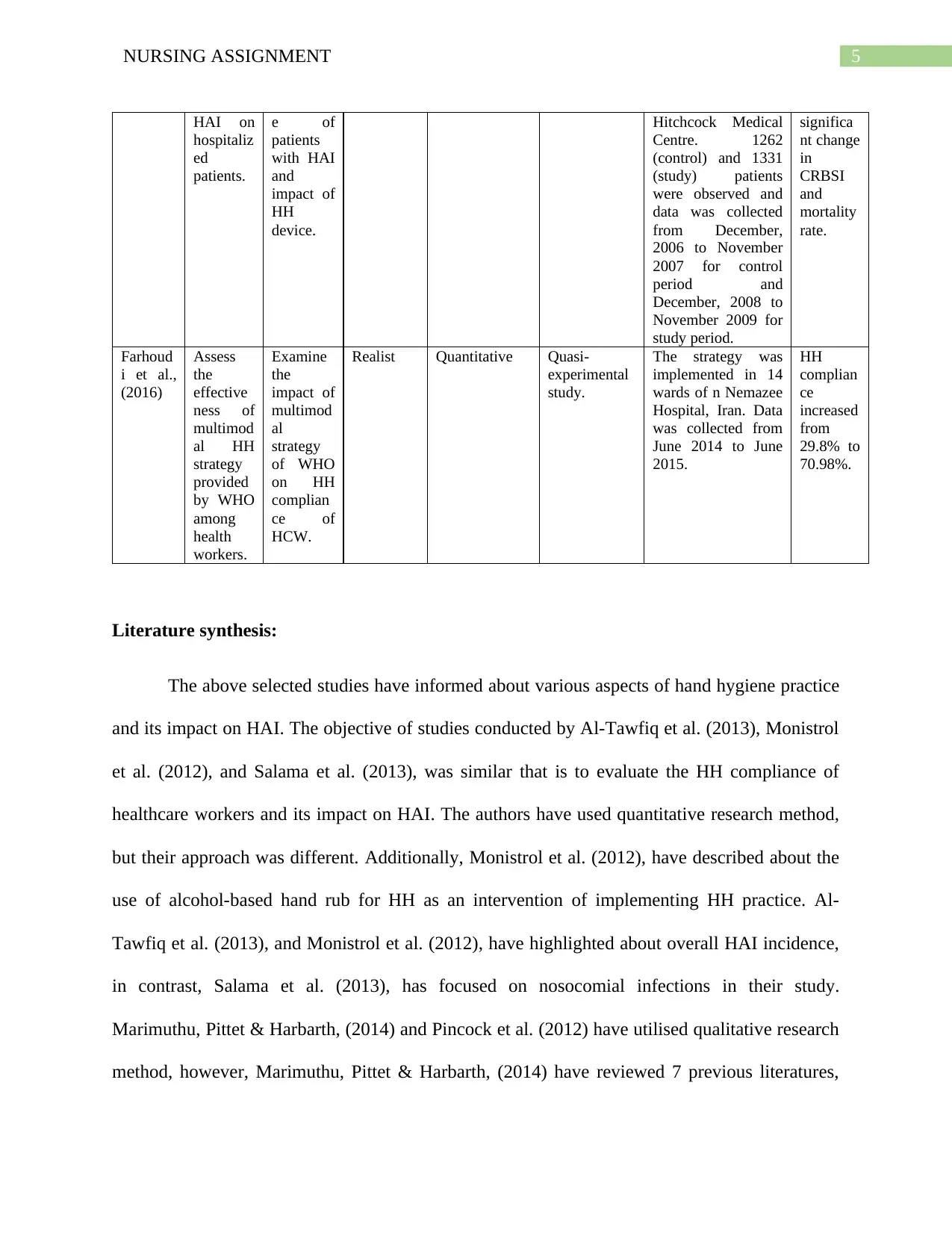
5NURSING ASSIGNMENT
HAI on
hospitaliz
ed
patients.
e of
patients
with HAI
and
impact of
HH
device.
Hitchcock Medical
Centre. 1262
(control) and 1331
(study) patients
were observed and
data was collected
from December,
2006 to November
2007 for control
period and
December, 2008 to
November 2009 for
study period.
significa
nt change
in
CRBSI
and
mortality
rate.
Farhoud
i et al.,
(2016)
Assess
the
effective
ness of
multimod
al HH
strategy
provided
by WHO
among
health
workers.
Examine
the
impact of
multimod
al
strategy
of WHO
on HH
complian
ce of
HCW.
Realist Quantitative Quasi-
experimental
study.
The strategy was
implemented in 14
wards of n Nemazee
Hospital, Iran. Data
was collected from
June 2014 to June
2015.
HH
complian
ce
increased
from
29.8% to
70.98%.
Literature synthesis:
The above selected studies have informed about various aspects of hand hygiene practice
and its impact on HAI. The objective of studies conducted by Al-Tawfiq et al. (2013), Monistrol
et al. (2012), and Salama et al. (2013), was similar that is to evaluate the HH compliance of
healthcare workers and its impact on HAI. The authors have used quantitative research method,
but their approach was different. Additionally, Monistrol et al. (2012), have described about the
use of alcohol-based hand rub for HH as an intervention of implementing HH practice. Al-
Tawfiq et al. (2013), and Monistrol et al. (2012), have highlighted about overall HAI incidence,
in contrast, Salama et al. (2013), has focused on nosocomial infections in their study.
Marimuthu, Pittet & Harbarth, (2014) and Pincock et al. (2012) have utilised qualitative research
method, however, Marimuthu, Pittet & Harbarth, (2014) have reviewed 7 previous literatures,
HAI on
hospitaliz
ed
patients.
e of
patients
with HAI
and
impact of
HH
device.
Hitchcock Medical
Centre. 1262
(control) and 1331
(study) patients
were observed and
data was collected
from December,
2006 to November
2007 for control
period and
December, 2008 to
November 2009 for
study period.
significa
nt change
in
CRBSI
and
mortality
rate.
Farhoud
i et al.,
(2016)
Assess
the
effective
ness of
multimod
al HH
strategy
provided
by WHO
among
health
workers.
Examine
the
impact of
multimod
al
strategy
of WHO
on HH
complian
ce of
HCW.
Realist Quantitative Quasi-
experimental
study.
The strategy was
implemented in 14
wards of n Nemazee
Hospital, Iran. Data
was collected from
June 2014 to June
2015.
HH
complian
ce
increased
from
29.8% to
70.98%.
Literature synthesis:
The above selected studies have informed about various aspects of hand hygiene practice
and its impact on HAI. The objective of studies conducted by Al-Tawfiq et al. (2013), Monistrol
et al. (2012), and Salama et al. (2013), was similar that is to evaluate the HH compliance of
healthcare workers and its impact on HAI. The authors have used quantitative research method,
but their approach was different. Additionally, Monistrol et al. (2012), have described about the
use of alcohol-based hand rub for HH as an intervention of implementing HH practice. Al-
Tawfiq et al. (2013), and Monistrol et al. (2012), have highlighted about overall HAI incidence,
in contrast, Salama et al. (2013), has focused on nosocomial infections in their study.
Marimuthu, Pittet & Harbarth, (2014) and Pincock et al. (2012) have utilised qualitative research
method, however, Marimuthu, Pittet & Harbarth, (2014) have reviewed 7 previous literatures,
⊘ This is a preview!⊘
Do you want full access?
Subscribe today to unlock all pages.

Trusted by 1+ million students worldwide
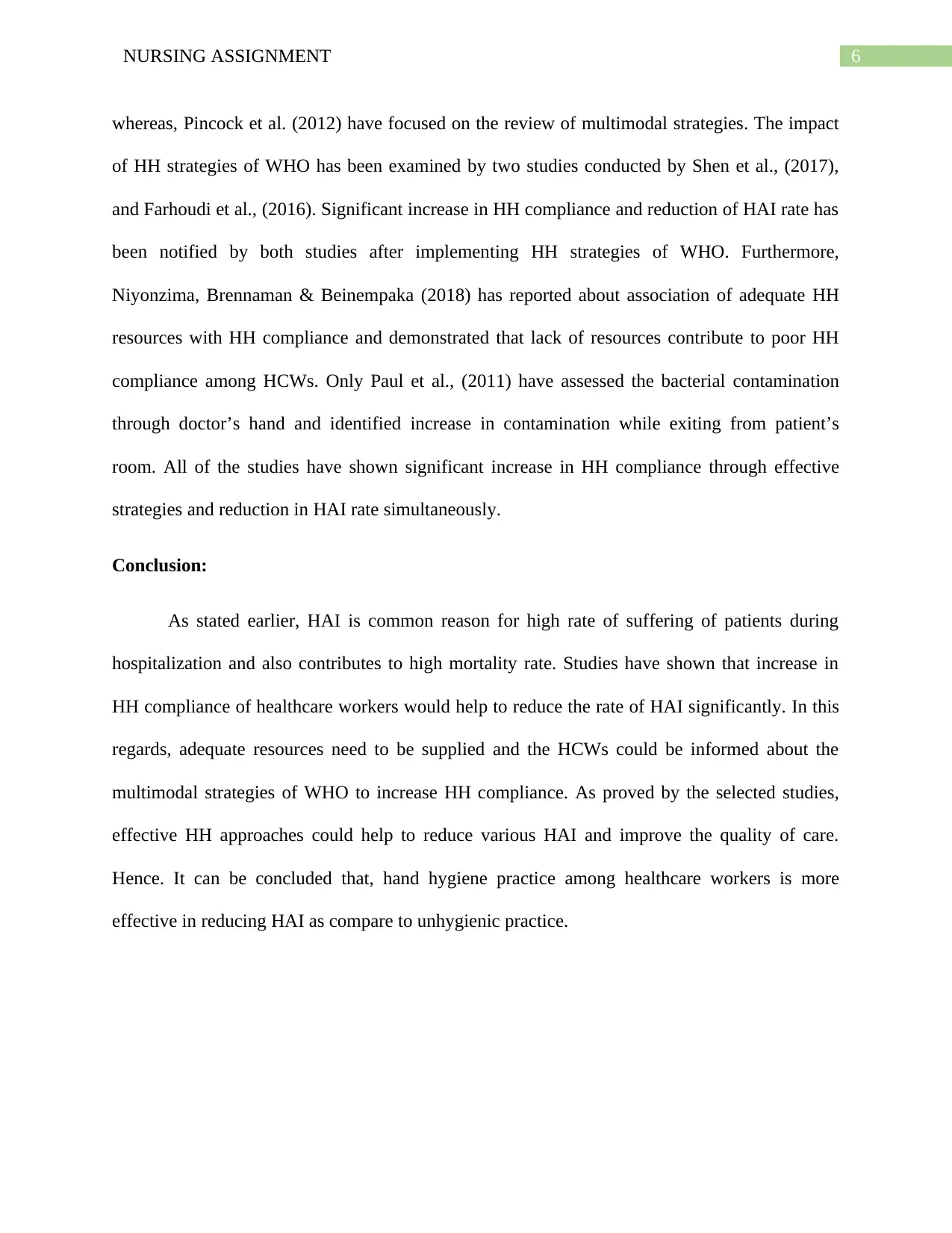
6NURSING ASSIGNMENT
whereas, Pincock et al. (2012) have focused on the review of multimodal strategies. The impact
of HH strategies of WHO has been examined by two studies conducted by Shen et al., (2017),
and Farhoudi et al., (2016). Significant increase in HH compliance and reduction of HAI rate has
been notified by both studies after implementing HH strategies of WHO. Furthermore,
Niyonzima, Brennaman & Beinempaka (2018) has reported about association of adequate HH
resources with HH compliance and demonstrated that lack of resources contribute to poor HH
compliance among HCWs. Only Paul et al., (2011) have assessed the bacterial contamination
through doctor’s hand and identified increase in contamination while exiting from patient’s
room. All of the studies have shown significant increase in HH compliance through effective
strategies and reduction in HAI rate simultaneously.
Conclusion:
As stated earlier, HAI is common reason for high rate of suffering of patients during
hospitalization and also contributes to high mortality rate. Studies have shown that increase in
HH compliance of healthcare workers would help to reduce the rate of HAI significantly. In this
regards, adequate resources need to be supplied and the HCWs could be informed about the
multimodal strategies of WHO to increase HH compliance. As proved by the selected studies,
effective HH approaches could help to reduce various HAI and improve the quality of care.
Hence. It can be concluded that, hand hygiene practice among healthcare workers is more
effective in reducing HAI as compare to unhygienic practice.
whereas, Pincock et al. (2012) have focused on the review of multimodal strategies. The impact
of HH strategies of WHO has been examined by two studies conducted by Shen et al., (2017),
and Farhoudi et al., (2016). Significant increase in HH compliance and reduction of HAI rate has
been notified by both studies after implementing HH strategies of WHO. Furthermore,
Niyonzima, Brennaman & Beinempaka (2018) has reported about association of adequate HH
resources with HH compliance and demonstrated that lack of resources contribute to poor HH
compliance among HCWs. Only Paul et al., (2011) have assessed the bacterial contamination
through doctor’s hand and identified increase in contamination while exiting from patient’s
room. All of the studies have shown significant increase in HH compliance through effective
strategies and reduction in HAI rate simultaneously.
Conclusion:
As stated earlier, HAI is common reason for high rate of suffering of patients during
hospitalization and also contributes to high mortality rate. Studies have shown that increase in
HH compliance of healthcare workers would help to reduce the rate of HAI significantly. In this
regards, adequate resources need to be supplied and the HCWs could be informed about the
multimodal strategies of WHO to increase HH compliance. As proved by the selected studies,
effective HH approaches could help to reduce various HAI and improve the quality of care.
Hence. It can be concluded that, hand hygiene practice among healthcare workers is more
effective in reducing HAI as compare to unhygienic practice.
Paraphrase This Document
Need a fresh take? Get an instant paraphrase of this document with our AI Paraphraser
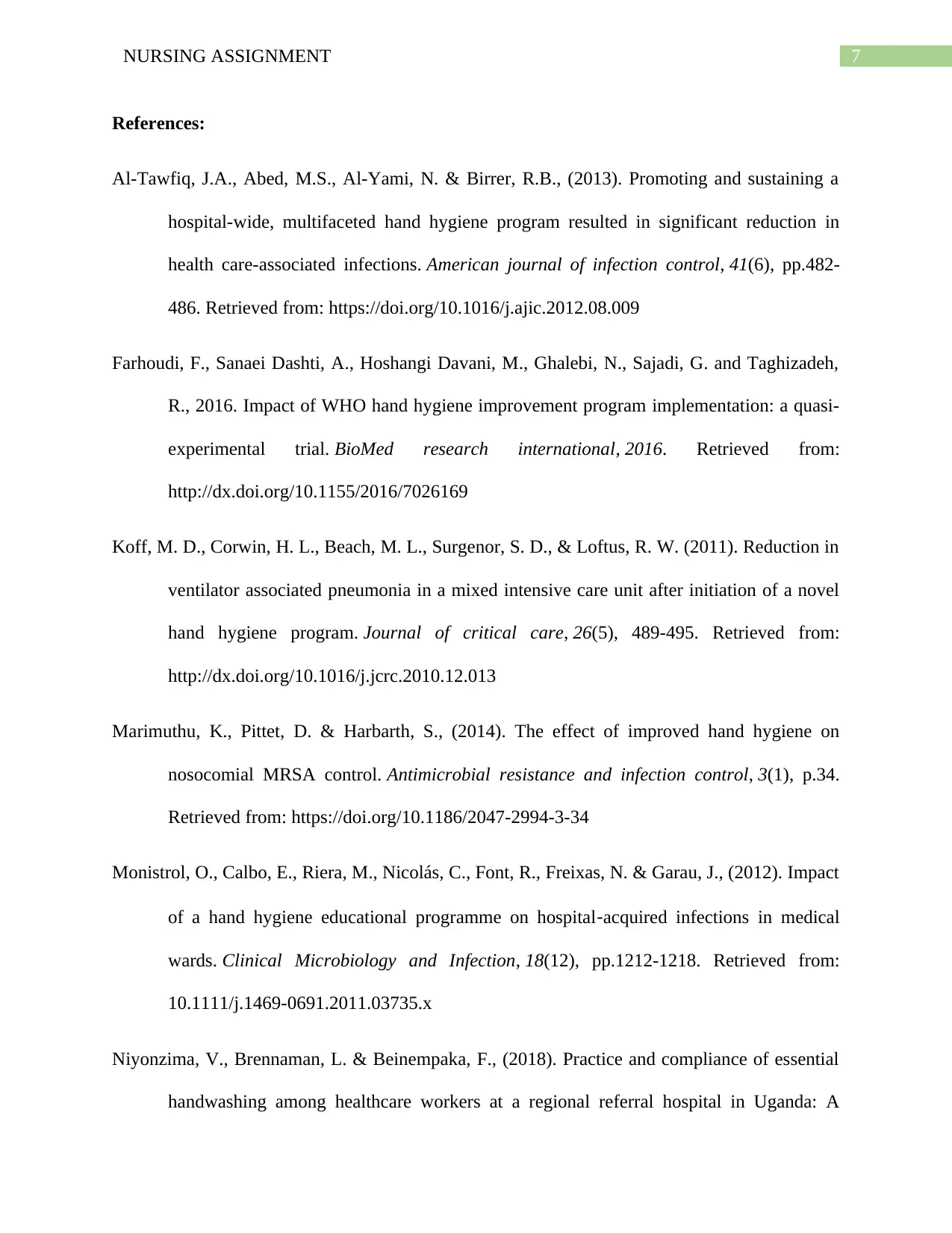
7NURSING ASSIGNMENT
References:
Al-Tawfiq, J.A., Abed, M.S., Al-Yami, N. & Birrer, R.B., (2013). Promoting and sustaining a
hospital-wide, multifaceted hand hygiene program resulted in significant reduction in
health care-associated infections. American journal of infection control, 41(6), pp.482-
486. Retrieved from: https://doi.org/10.1016/j.ajic.2012.08.009
Farhoudi, F., Sanaei Dashti, A., Hoshangi Davani, M., Ghalebi, N., Sajadi, G. and Taghizadeh,
R., 2016. Impact of WHO hand hygiene improvement program implementation: a quasi-
experimental trial. BioMed research international, 2016. Retrieved from:
http://dx.doi.org/10.1155/2016/7026169
Koff, M. D., Corwin, H. L., Beach, M. L., Surgenor, S. D., & Loftus, R. W. (2011). Reduction in
ventilator associated pneumonia in a mixed intensive care unit after initiation of a novel
hand hygiene program. Journal of critical care, 26(5), 489-495. Retrieved from:
http://dx.doi.org/10.1016/j.jcrc.2010.12.013
Marimuthu, K., Pittet, D. & Harbarth, S., (2014). The effect of improved hand hygiene on
nosocomial MRSA control. Antimicrobial resistance and infection control, 3(1), p.34.
Retrieved from: https://doi.org/10.1186/2047-2994-3-34
Monistrol, O., Calbo, E., Riera, M., Nicolás, C., Font, R., Freixas, N. & Garau, J., (2012). Impact
of a hand hygiene educational programme on hospital‐acquired infections in medical
wards. Clinical Microbiology and Infection, 18(12), pp.1212-1218. Retrieved from:
10.1111/j.1469-0691.2011.03735.x
Niyonzima, V., Brennaman, L. & Beinempaka, F., (2018). Practice and compliance of essential
handwashing among healthcare workers at a regional referral hospital in Uganda: A
References:
Al-Tawfiq, J.A., Abed, M.S., Al-Yami, N. & Birrer, R.B., (2013). Promoting and sustaining a
hospital-wide, multifaceted hand hygiene program resulted in significant reduction in
health care-associated infections. American journal of infection control, 41(6), pp.482-
486. Retrieved from: https://doi.org/10.1016/j.ajic.2012.08.009
Farhoudi, F., Sanaei Dashti, A., Hoshangi Davani, M., Ghalebi, N., Sajadi, G. and Taghizadeh,
R., 2016. Impact of WHO hand hygiene improvement program implementation: a quasi-
experimental trial. BioMed research international, 2016. Retrieved from:
http://dx.doi.org/10.1155/2016/7026169
Koff, M. D., Corwin, H. L., Beach, M. L., Surgenor, S. D., & Loftus, R. W. (2011). Reduction in
ventilator associated pneumonia in a mixed intensive care unit after initiation of a novel
hand hygiene program. Journal of critical care, 26(5), 489-495. Retrieved from:
http://dx.doi.org/10.1016/j.jcrc.2010.12.013
Marimuthu, K., Pittet, D. & Harbarth, S., (2014). The effect of improved hand hygiene on
nosocomial MRSA control. Antimicrobial resistance and infection control, 3(1), p.34.
Retrieved from: https://doi.org/10.1186/2047-2994-3-34
Monistrol, O., Calbo, E., Riera, M., Nicolás, C., Font, R., Freixas, N. & Garau, J., (2012). Impact
of a hand hygiene educational programme on hospital‐acquired infections in medical
wards. Clinical Microbiology and Infection, 18(12), pp.1212-1218. Retrieved from:
10.1111/j.1469-0691.2011.03735.x
Niyonzima, V., Brennaman, L. & Beinempaka, F., (2018). Practice and compliance of essential
handwashing among healthcare workers at a regional referral hospital in Uganda: A
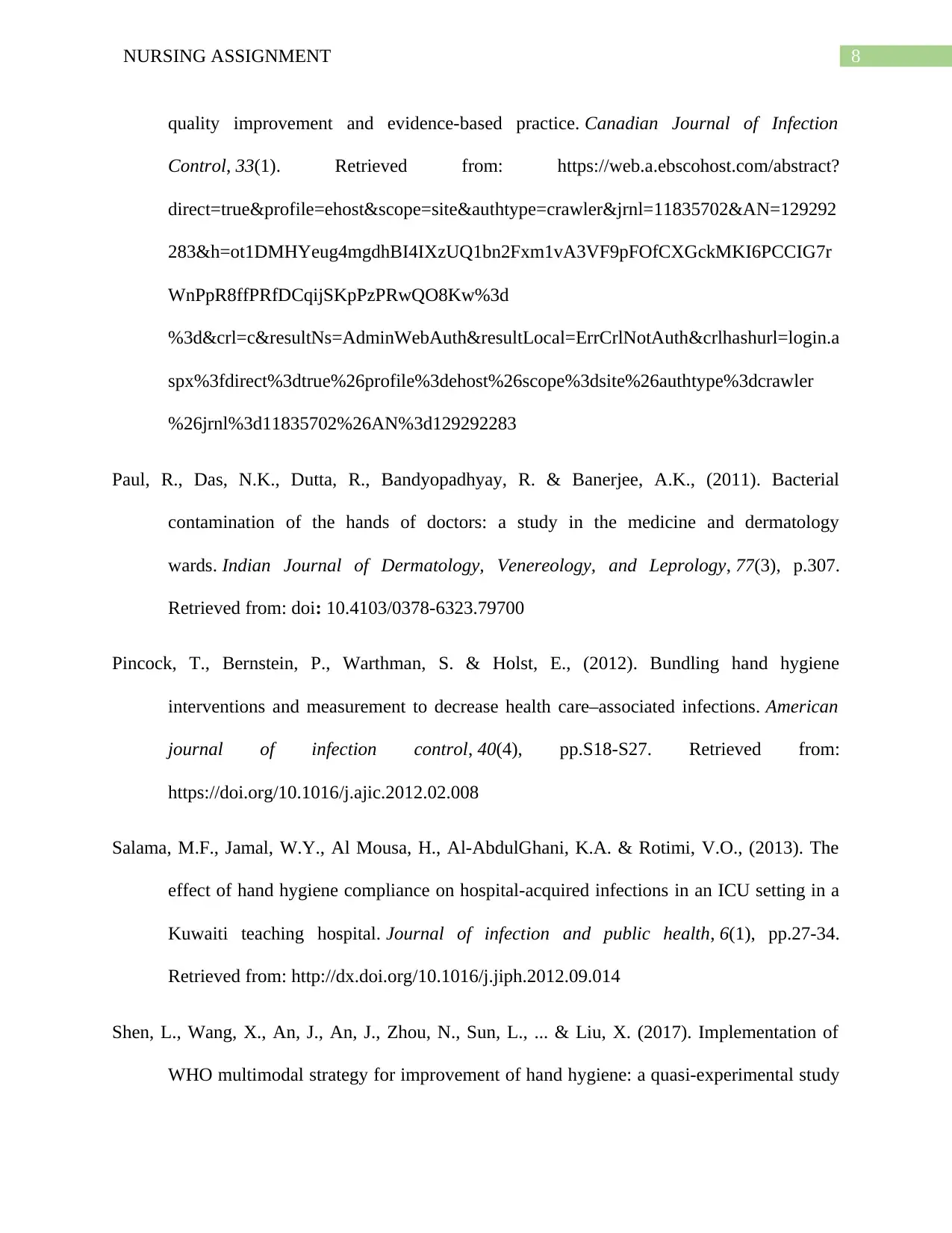
8NURSING ASSIGNMENT
quality improvement and evidence-based practice. Canadian Journal of Infection
Control, 33(1). Retrieved from: https://web.a.ebscohost.com/abstract?
direct=true&profile=ehost&scope=site&authtype=crawler&jrnl=11835702&AN=129292
283&h=ot1DMHYeug4mgdhBI4IXzUQ1bn2Fxm1vA3VF9pFOfCXGckMKI6PCCIG7r
WnPpR8ffPRfDCqijSKpPzPRwQO8Kw%3d
%3d&crl=c&resultNs=AdminWebAuth&resultLocal=ErrCrlNotAuth&crlhashurl=login.a
spx%3fdirect%3dtrue%26profile%3dehost%26scope%3dsite%26authtype%3dcrawler
%26jrnl%3d11835702%26AN%3d129292283
Paul, R., Das, N.K., Dutta, R., Bandyopadhyay, R. & Banerjee, A.K., (2011). Bacterial
contamination of the hands of doctors: a study in the medicine and dermatology
wards. Indian Journal of Dermatology, Venereology, and Leprology, 77(3), p.307.
Retrieved from: doi: 10.4103/0378-6323.79700
Pincock, T., Bernstein, P., Warthman, S. & Holst, E., (2012). Bundling hand hygiene
interventions and measurement to decrease health care–associated infections. American
journal of infection control, 40(4), pp.S18-S27. Retrieved from:
https://doi.org/10.1016/j.ajic.2012.02.008
Salama, M.F., Jamal, W.Y., Al Mousa, H., Al-AbdulGhani, K.A. & Rotimi, V.O., (2013). The
effect of hand hygiene compliance on hospital-acquired infections in an ICU setting in a
Kuwaiti teaching hospital. Journal of infection and public health, 6(1), pp.27-34.
Retrieved from: http://dx.doi.org/10.1016/j.jiph.2012.09.014
Shen, L., Wang, X., An, J., An, J., Zhou, N., Sun, L., ... & Liu, X. (2017). Implementation of
WHO multimodal strategy for improvement of hand hygiene: a quasi-experimental study
quality improvement and evidence-based practice. Canadian Journal of Infection
Control, 33(1). Retrieved from: https://web.a.ebscohost.com/abstract?
direct=true&profile=ehost&scope=site&authtype=crawler&jrnl=11835702&AN=129292
283&h=ot1DMHYeug4mgdhBI4IXzUQ1bn2Fxm1vA3VF9pFOfCXGckMKI6PCCIG7r
WnPpR8ffPRfDCqijSKpPzPRwQO8Kw%3d
%3d&crl=c&resultNs=AdminWebAuth&resultLocal=ErrCrlNotAuth&crlhashurl=login.a
spx%3fdirect%3dtrue%26profile%3dehost%26scope%3dsite%26authtype%3dcrawler
%26jrnl%3d11835702%26AN%3d129292283
Paul, R., Das, N.K., Dutta, R., Bandyopadhyay, R. & Banerjee, A.K., (2011). Bacterial
contamination of the hands of doctors: a study in the medicine and dermatology
wards. Indian Journal of Dermatology, Venereology, and Leprology, 77(3), p.307.
Retrieved from: doi: 10.4103/0378-6323.79700
Pincock, T., Bernstein, P., Warthman, S. & Holst, E., (2012). Bundling hand hygiene
interventions and measurement to decrease health care–associated infections. American
journal of infection control, 40(4), pp.S18-S27. Retrieved from:
https://doi.org/10.1016/j.ajic.2012.02.008
Salama, M.F., Jamal, W.Y., Al Mousa, H., Al-AbdulGhani, K.A. & Rotimi, V.O., (2013). The
effect of hand hygiene compliance on hospital-acquired infections in an ICU setting in a
Kuwaiti teaching hospital. Journal of infection and public health, 6(1), pp.27-34.
Retrieved from: http://dx.doi.org/10.1016/j.jiph.2012.09.014
Shen, L., Wang, X., An, J., An, J., Zhou, N., Sun, L., ... & Liu, X. (2017). Implementation of
WHO multimodal strategy for improvement of hand hygiene: a quasi-experimental study
⊘ This is a preview!⊘
Do you want full access?
Subscribe today to unlock all pages.

Trusted by 1+ million students worldwide
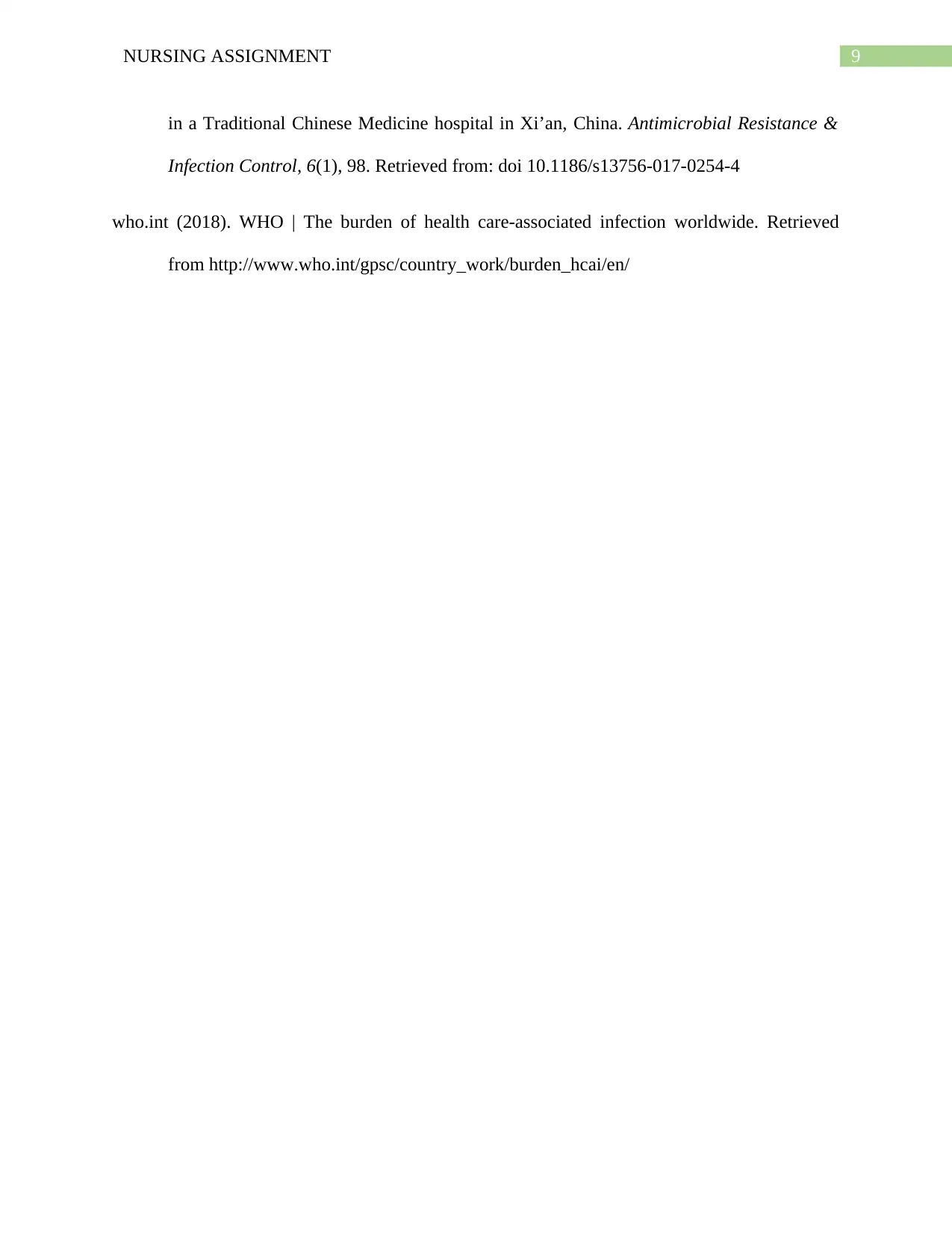
9NURSING ASSIGNMENT
in a Traditional Chinese Medicine hospital in Xi’an, China. Antimicrobial Resistance &
Infection Control, 6(1), 98. Retrieved from: doi 10.1186/s13756-017-0254-4
who.int (2018). WHO | The burden of health care-associated infection worldwide. Retrieved
from http://www.who.int/gpsc/country_work/burden_hcai/en/
in a Traditional Chinese Medicine hospital in Xi’an, China. Antimicrobial Resistance &
Infection Control, 6(1), 98. Retrieved from: doi 10.1186/s13756-017-0254-4
who.int (2018). WHO | The burden of health care-associated infection worldwide. Retrieved
from http://www.who.int/gpsc/country_work/burden_hcai/en/
Paraphrase This Document
Need a fresh take? Get an instant paraphrase of this document with our AI Paraphraser
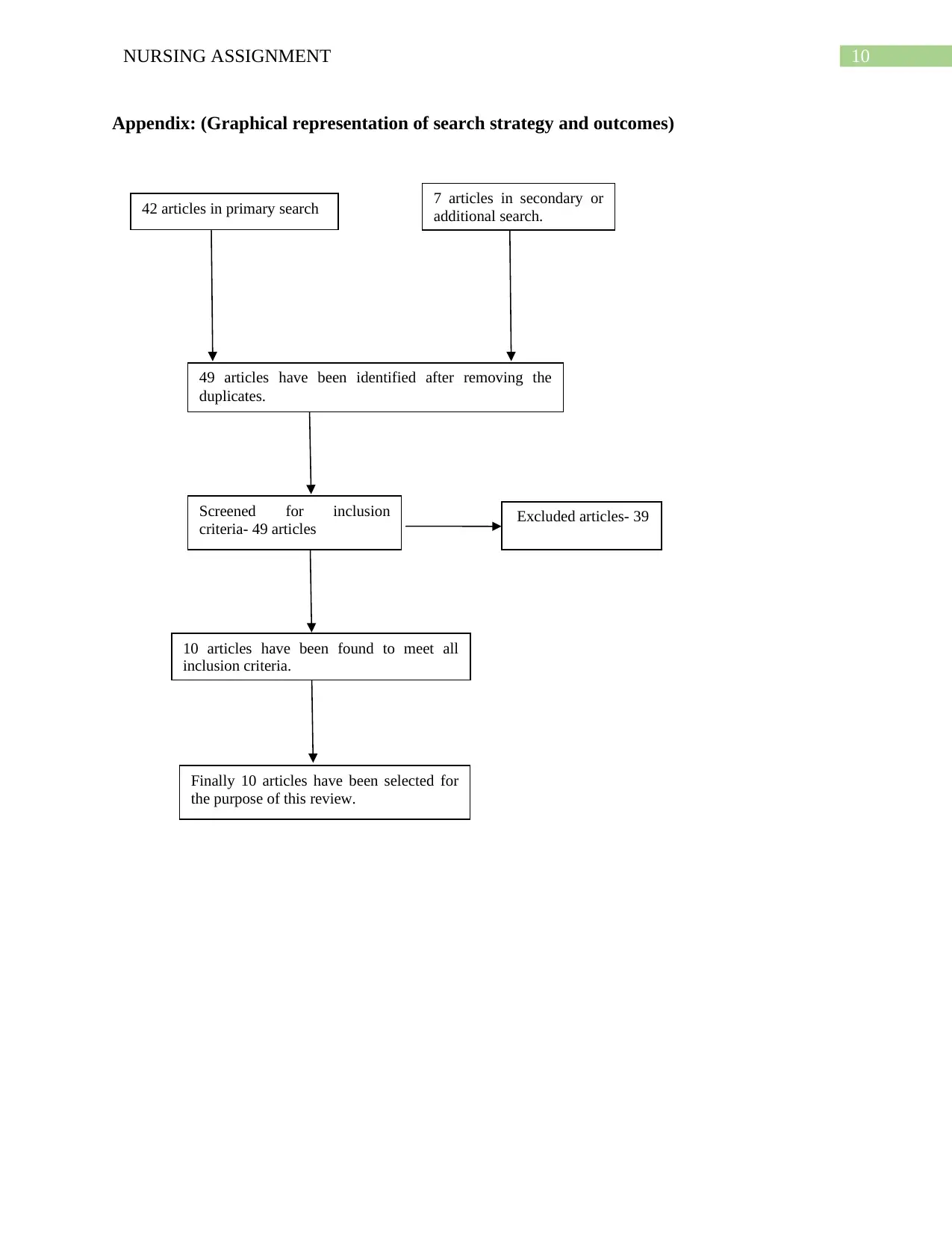
10NURSING ASSIGNMENT
Appendix: (Graphical representation of search strategy and outcomes)
42 articles in primary search 7 articles in secondary or
additional search.
49 articles have been identified after removing the
duplicates.
Screened for inclusion
criteria- 49 articles
10 articles have been found to meet all
inclusion criteria.
Finally 10 articles have been selected for
the purpose of this review.
Excluded articles- 39
Appendix: (Graphical representation of search strategy and outcomes)
42 articles in primary search 7 articles in secondary or
additional search.
49 articles have been identified after removing the
duplicates.
Screened for inclusion
criteria- 49 articles
10 articles have been found to meet all
inclusion criteria.
Finally 10 articles have been selected for
the purpose of this review.
Excluded articles- 39

11NURSING ASSIGNMENT
⊘ This is a preview!⊘
Do you want full access?
Subscribe today to unlock all pages.

Trusted by 1+ million students worldwide
1 out of 12
Related Documents
Your All-in-One AI-Powered Toolkit for Academic Success.
+13062052269
info@desklib.com
Available 24*7 on WhatsApp / Email
![[object Object]](/_next/static/media/star-bottom.7253800d.svg)
Unlock your academic potential
Copyright © 2020–2025 A2Z Services. All Rights Reserved. Developed and managed by ZUCOL.





